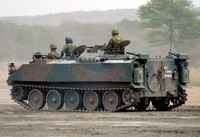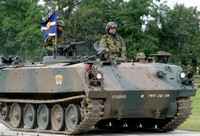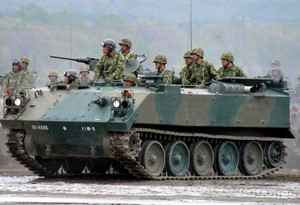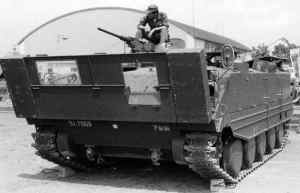| Designation: | Type 73 |
 |
|---|---|---|
| Manufacturer: | Mitsubishi Heavy Industries | |
| Product type: | Armoured Vehicles | |
| Name: | Tracked armoured personnel carrier |
The first production of the Type 73 was in 1974, built by Hitachi as a domestic replacement for the American M4 and M8 high-speed tractors. It was never produced in large numbers, as self-propelled artillery became the new focus.
The cab and gun crew compartments of the Type 73 are fully enclosed steel designs, with ammunition carried in a separate compartment at the rear. A 400 hp Mitsubishi diesel engine powers full tracks, and armament is a single 12.7mm anti-aircraft machine gun.
The Type 73 was intended to tow weapons such as the 155 mm Long Tom gun and the M115 203 mm howitzer. It can also be fitted with a dozer blade.
The development of a new Japanese armoured personnel carrier to supplement the older SU 60 began in FY67 under the direction of the Technical Research and Development Institution of the Japanese Defence Agency.
In January 1967, the following requirements were issued for the new APC: maximum speed of over 60 km/h, ability to carry 12 men including the crew, to be fully amphibious, have all-welded aluminium armour, provision for the infantry to use their small arms from inside the vehicle and be armed with a 20 mm cannon, a 12.7 mm machine gun and a 7.62 mm machine gun.
In 1967, the following manufacturers started on the production of specific components: Hitachi Manufacturing Company (transmission), Kobe Iron Works (aluminium alloy), Komatsu Manufacturing Company (tracks), Mitsubishi Heavy Industries (engine, steering and suspension), and Nihon Electric Corporation (night vision equipment).
In 1968, an automotive test rig, called the SUT, was completed and tested. The following year Mitsubishi Heavy Industries and the Komatsu Manufacturing Company each built two prototype vehicles: one steel and one aluminium.
After trials, in December 1972, the second prototype of the Mitsubishi model, with aluminium armour, was selected for use by the Japanese Ground Self-Defence Force and after minor modifications and improvements was standardised as the Type 73 APC
It is believed that total production of the Type 73 amounted to 340 vehicles. The Type 73 and Type SU 60 have now been supplemented by the new Type 89 MICV covered in the previous entry.
As the Type 89 MICV was built in very small numbers, the older Type 73 APC will remain in service with the Japanese Ground Self-Defence Force well into the 21st century. A total of 337 Type 73 APCs were in service by the end of 1999.
The hull of the Type 73 APC is made of all-welded aluminium armour, which provides the occupants with protection from small arms fire and shell splinters. The 7.62 mm bow machine gunner seated at the front of the hull on the left side. The 7.62 mm bow machine gun has an elevation, depression and traverse of 30°. The gunner has a single-piece hatch cover that opens to the left and has a single day periscope, which can be traversed through 360°.
The driver sits at the front of the hull on the right side and has a single-piece hatch cover that lifts and swings horizontally to the rear to open, and an integral day periscope. To the front of the driver's position are three day periscopes. One of these can be replaced by a passive periscope for night driving.
The commander sits slightly behind the bow machine gunner and driver and has a single-piece hatch cover opening to the rear. Six day vision blocks give the commander all-round observation.
The Mitsubishi 4ZF diesel engine is mounted to the rear of the bow machine gunner on the left side of the hull with the air inlet, outlet and exhaust pipe in the roof. The engine and transmission are mounted as a power pack and can be removed from the vehicle as a complete unit in half an hour. The machine gunner sits behind the driver and has a cupola that can be traversed through a full 360°. The cupola has a single-piece hatch cover that opens to the rear and six day periscopes for all-round observation. The 0.50 (12.7 mm) M2 HB machine gun is not provided with a shield, as it can be aimed and fired from inside the cupola. The 0.50 (12.7 mm) machine gun has an elevation of +60°, depression of -10° and can be traversed through 360°.
The Type 73 carries nine infantrymen, one of whom normally mans the 0.50 (12.7 mm) M2 machine gun position. The eight infantrymen sit in the troop compartment at the rear of the hull down either side on seats that can be folded up, and enter the vehicle via two doors that open outwards at the rear of the hull. There is a T-shaped firing port in each door and two in each side of the troop compartment. Over the top of the troop compartment are two single-piece hatch covers that open either side of the hull top. Mounted at the very rear of the hull top, one either side, is a three-barrelled smoke grenade discharger that fires forwards over the front of the vehicle.
The torsion bar suspension consists of five dual rubber-tyred road wheels with the drive sprocket at the front and the idler at the rear. There are no track-return rollers. A hydraulic shock-absorber is provided for the first road wheel station.
The basic model of the Type 73 APC is not amphibious although an amphibious kit has been developed and fitted to some vehicles. The kit consists of: buoyancy aids attached to the outside of each of the road wheels; skirts fitted to cover the upper part of the tracks to improve water flow; box-type structures fitted on top of the hull over the air inlet, outlet and exhaust to stop water entering when afloat; and a trim vane fitted on the front of the hull. The trim vane is in two parts and is hinged horizontally. A transparent panel in the right side provides forward vision for the driver. When afloat, the vehicle is propelled in the water by its tracks.
The Type 73 is fitted with passive night vision equipment and an NBC system.
The Type 75 self-propelled ground wind measuring unit is used in conjunction with the Type 75 self-propelled 130 mm multiple rocket launcher (full details of this are given in the Multiple rocket launchers section) which also uses some components of the Type 73. The measuring unit has a mast which when extended is 12.5 m high and can measure wind velocity in two directions. The wind velocity measuring equipment was developed by Meisei Electric.
The Type 74 105 mm self-propelled howitzer and Type 75 multiple rocket launcher both use the same engine as the Type 73. There is also a command post version of the Type 73, which has a higher roof with hatches to the rear of the commander's cupola.
|
||||||||||||
 |
 |
 |
 |
 |
 |
